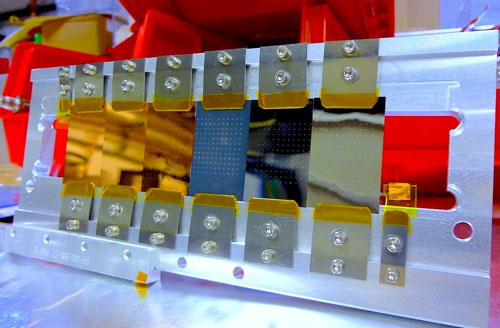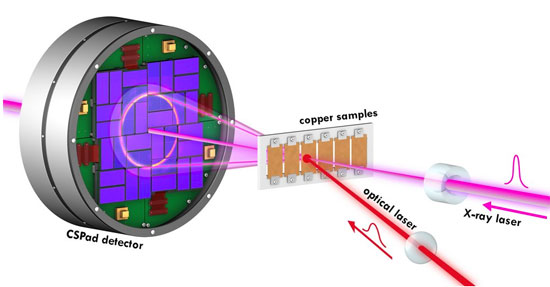| Oct 22, 2013 |
Copper shock: An atomic-scale stress test (w/video)
|
|
(Nanowerk News) Scientists used the powerful X-ray laser at the U.S. Department of Energy's SLAC National Accelerator Laboratory to create movies detailing trillionths-of-a-second changes in the arrangement of copper atoms after an extreme shock. Movies like these will help researchers create new kinds of materials and test the strength of existing ones.
|
|
This work, published Oct. 11 in Science ("Femtosecond Visualization of Lattice Dynamics in Shock-Compressed Matter"), pinpointed the precise breaking point when the extreme pressures began to permanently deform the copper structure, or lattice, so it could no longer bounce back to its original shape. Such experiments provide a direct test of complex computer simulations that model the behavior of many millions of atoms within tiny samples of material.
|
 |
| These thin samples of copper, iron and titanium were shocked with optical laser pulses and probed with SLAC's X-ray laser, the Linac Coherent Light Source (LCLS).
|
|
Such simulations are used to design stronger, more durable materials – such as shielding for satellites to withstand high-speed pelting by space debris – but they have been hard to test in the lab because of the tiny samples and short timescales involved.
|
|
"The results enable a number of materials experiments that can be compared to simulations at the same scales," said Despina Milathianaki, a staff scientist at SLAC's Linac Coherent Light Source (LCLS) who led the experiment. "This and future experiments, designed to provide a direct comparison with simulations, will help us to accurately predict the strength of materials in extreme conditions."
|
|
A sequence of X-ray diffraction images, 10 trillionths of a second apart, shows how a shock impacts the crystal structure, or lattice, of copper at the atomic scale. (D. Milathianaki, S. Boutet, et al./SLAC Multimedia)
|
 |
| A diagram of the setup used in the ultrafast shock compression experiment at SLAC's Linac Coherent Light Source (LCLS), including a large-area CSPAD detector, X-ray and optical lasers, and thin copper samples.
|
|
In this experiment, researchers shocked a layer of copper about 1 thousandth of a millimeter, or 1 micron thick with optical laser pulses, and then probed the copper’s lattice with ultrabright X-ray pulses. They compiled the X-ray images into atomic-scale movies that detail how the lattice responded at various times after the shock, including the moment the copper reached its breaking point.
|
|
"The demand for research time at LCLS is already at a premium, and these results demonstrate yet another new technique that we believe will open the door to a host of new experiments," said Sebastien Boutet, who leads LCLS's Coherent X-ray Imaging (CXI) Department, where the measurements were performed.
|
|
|
|
A sequence of X-ray diffraction images, 10 trillionths of a second apart, shows how a shock impacts the crystal structure, or lattice, of copper at the atomic scale.
|
|
The same research team – composed mostly of SLAC scientists, with collaborators from University of Oxford, Stanford University and Lawrence Livermore National Laboratory – also shocked other metals, including iron and titanium, and is analyzing the data obtained from those samples.
|
|
Follow-up research scheduled at LCLS in March seeks to extend the research to additional materials and to enlist other x-ray scattering techniques, which may provide more details about the origins of the damage in the lattice.
|


